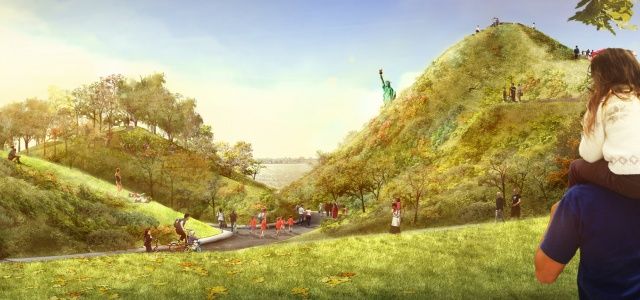Last-Minute NYC Holiday Gift Guide 🎁
We’ve created a holiday gift guide with presents for the intrepid New Yorker that should arrive just in time—


A rendering of The Hills. Source: West 8.
A series of recycled hills are rising on Governors Island. Last Friday, Mayor Bloomberg broke ground on The Hills, one of the island’s new parks that’s part of a city initiative to transform it into a modern public space. The project has the backing of Google founder Eric Schmidt and his wife, who announced a donation of $15 million at the groundbreaking.
Originally, the southern half of the island had been used as a landfill, like nearby Fresh Kills Park. But, like Central Park, The Hills will alter the existing terrain by introducing man-made slopes of recycled construction materials. The four hills will range in height from 46 to 82 feet above sea level and offer panoramic views of the Manhattan skyline, the Statue of Liberty and New York Harbor.
The 11-acre park is set to open to the public in 2015. In the meantime, four other parks totaling 30 acres on the island will open by the end of the year. They include Liggett Terrace, a plaza with moveable seating; a 10-acre hammock grove; two turf fields and a lawn; and a 34-acre Historic District of flexible space.

Hammock Grove will contain 300 trees of 55 species and offer a place for relaxation. Source: West 8.
Since Bill Clinton (on behalf of the federal government) sold over 150 acres of Governors Island to New York state and city for $1 in 1995, Governors Island has slowly transformed from a former military base into a popular summer destination for New Yorkers. But this change isn’t happening fast enough. The city always planned for the island to be self-sustaining, but in the last two years, has paid $11.5 million a year in maintenance and a total $250 million commitment to develop the island. While this is a considerable sum, it’s not enough to support the development without turning to private donors.

The Great Promenade will run for 2.2 miles along the perimeter of the island. Source: West 8.
Public-private partnerships in public development seem to be growing, especially with shortage of public funds. Along with the Schmidts’ gift, the nonprofit Trust for Governors Island (a city-led development corporation) has collected $36 million of the construction’s $70 million projected costs. Other notable private contributors include Mayor Bloomberg, Tiffany & Co. Foundation and the Lauder Foundation. Similar private gifts from high-profile donors like Diane von Furstenberg helped fund development of the High Line and Brooklyn Bridge Park. Even Central Park is largely maintained by personal donations to the Central Park Conservancy. Meanwhile, projects like Pier 40 have struggled to find private funding (though that could change if the Hudson River Park Trust sells the pier’s air rights to private developers).
While private donations have been crucial in getting these projects off the ground, there has been some public anxiety that private interests will limit equal access to these spaces. According to the Wall Street Journal, while nearly everyone sees the necessity of some private support for parks, it’s worth being conscious of the fact that private donors can’t completely shoulder costs that dwindling municipal budgets leave.
Aside from the acres of parkland currently under construction, there’s still opportunity for development of over 110 acres on the island’s southern half. In addition, the National Park Service owns 22 acres of the island that it oversees under a general management plan.
According to Robert Pirani of the Regional Plan Association, the most viable uses of the island currently include education, hospitality, cultural and recreational uses. There’s the potential that parts of Governors Island could be used for student dorms, artist housing, hotels or small-scale offices. Beyond development, however, maintenance is also a concern.
“It’s not just building the park space, but it’s also thing about its long-term stewardship,” Pirani said. No matter the development, it is important for the activities of the island’s future tenants to be self-sustaining.
“There is this accelerating notion that not just parks but many aspects of the public realm have to be self-financing,” Michael Sorkin, director of the graduate program in urban design at the City College of New York, told the New York Times. “The paradox is that it’s always amounting to giving away some public good in order to realize some other public good.”
Get in touch with the author @catku.
Subscribe to our newsletter